… I’ll have a decent night.
But it wasn’t last night, that’s for sure. With all of the excitement following Belgium’s unexpected victory over Brazil there was chaos in the streets and enough noise to awaken the dead.
And so despite everything and all of my best intentions, it was hours before I managed to go off to sleep.
It was another morning too where I was awake long before the alarm went off. When I finally glanced at the time it was 05:47 and I was hoping for something rather better than that.
There had still been time to go on my travels though. Back driving a taxi and I’d been given a list of the regular clients which I was sure that I had memorised, and so I tore it up. And immediately there was a call over the radio “go to Nantwich and pick up so-and-so”. And I couldn’t remember where he or she lived. My notes were too badly torn to be able to be pieced together so I asked on the radio, but I couldn’t understand the reply which was rather garbled.
A little later I was in Eritrea (don’t ask me why) – an Eritrea that looked like nothing that I had ever seen of it. There was a military patrol walking down a road floating up observation balloons, many of which had fallen to earth and were littering the side of the road. Suddenly the patrol withdrew, leaving me isolated right out in front, a rather nervous place to be. Eventually I found a tourist guide who was selling tickets on a steam train ride. he was negotiating with someone and they agreed on a price of $50:00. The only thing that I could see in the brochure for a steam ride was at $130:00 so I asked about it. He replied that I needed to go to the railway station and book it there. He mentioned 13:30 but I didn’t understand if that was the time of departure or the time of return, and it was all so confusing.
So crawling out of bed I had my medication (now that I have some) but I still didn’t feel like any breakfast so I had a shower instead and cracked on with my paperwork.
The cleaner wanted to come in here at 11:00 but I told her to wait for a while as I was expecting a visitor.
And sure enough, just when I reckoned that I ought to go outside, I opened my door to see Alison pulling into the car park. Bang on cue.
 Our first port of call was about 30 kms down the road in Welkenraedt.
Our first port of call was about 30 kms down the road in Welkenraedt.
Despite only having a population on 9,000 or so, it’s probably one of the most famous small towns in Belgium and it’s one that I’ve been dying to visit ever since I first came to Oostende over 45years ago
And for one of the strangest reasons too, because it’s not your usual run-of-the-mill tourist venue.
Back in the 1970s at the railway station in Oostende there would alwas be a train waiting to meet the ferries, and they would always be going to Welkenraedt.
It aroused my curiosity so I did a little research and found that it was a small town in the north of the Ardennes that didn’t look as if it had any significance at all, so I was puzzled as to why all of these trains would want to come here.
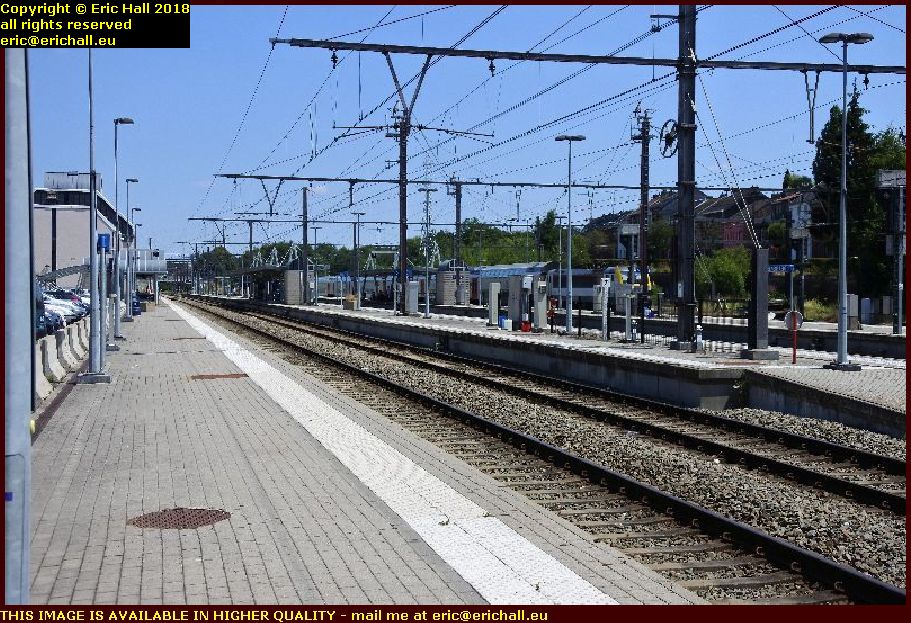 And when you look at the station, it’s a big, modern station that has plenty of facilities and it is all out of proportion to the size of the town
And when you look at the station, it’s a big, modern station that has plenty of facilities and it is all out of proportion to the size of the town
A little bit of research back in those days soon cleared up the question.
Welkenraedt is the closest railway station to the border between Germany and Belgium – in Germany until 1919 and in Belgium afterwards.
And when the railways were electrified, the German voltage system was different from that in Belgium until comparatively modern times. And until the Schengen agreement, there was a frontier post at the station.
So while the passengers were having their passports controlled, the train would be changing engines and then going on to Aachen or Cologne or maybe further still.
Welkenraedt is officially a German-speaking town but when it was transferred to Belgium by the Treaty of Versailles, the SNCB, the Belgian railway company, opened a locomotive depot here and transferred in a large number of French-speaking railway workers.
They flooded the town to such an extent that you will struggle to find German spoken here today. We saw a couple of signs in German but that was about that.
We went off to find something to eat as Alison was hungry, and I forced down a helping of overcooked chips. I’m clearly feeling better after my crisis of Thursday and Friday.
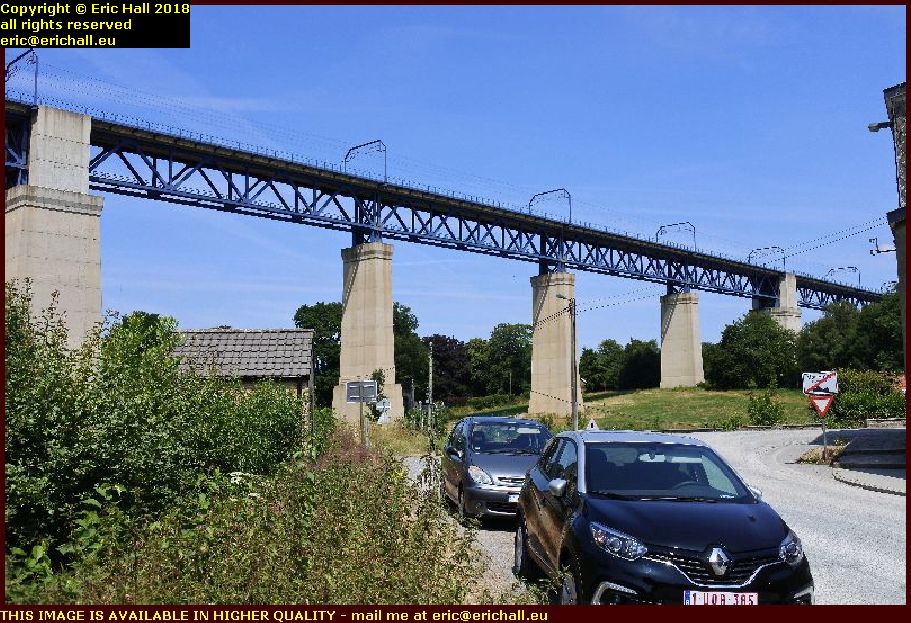 But you can’t cometo this region without going down the road to Moresnet.
But you can’t cometo this region without going down the road to Moresnet.
For several reasons really, not the first of which is this absolutely gorgeous railway viaduct.
It’s not quite on a par with the Tracel de Cap Rouge of course, that’s rather exceptional, but it’s by far the best that you are likely to find around this part of Europe.
 According to the information that I have found, it was built during the period 1915-1916. The pillars are fine examples of reinforced concrete of that period.
According to the information that I have found, it was built during the period 1915-1916. The pillars are fine examples of reinforced concrete of that period.
It’s just over 1100 metres long and at its highest, it’s about 60 metres above the velley of the River Gueule
That tells us a couple of things
- There may well have been something here prior to that period that was demolished at the start of World War I
- It escaped demolition during the fighting of World War II
 Knowing my usual luck, we would ordinarily have had to wait for about three weeks to see a train pass over the viaduct, and then we would have missed it because we had gone for a coffee.
Knowing my usual luck, we would ordinarily have had to wait for about three weeks to see a train pass over the viaduct, and then we would have missed it because we had gone for a coffee.
But that’s not the case here. This is the main railway line that runs between Aachen and Antwerpen, one of Europe’s busiest ports.
We’d hardly pulled into the village before a freight train went rattling by just above our heads.
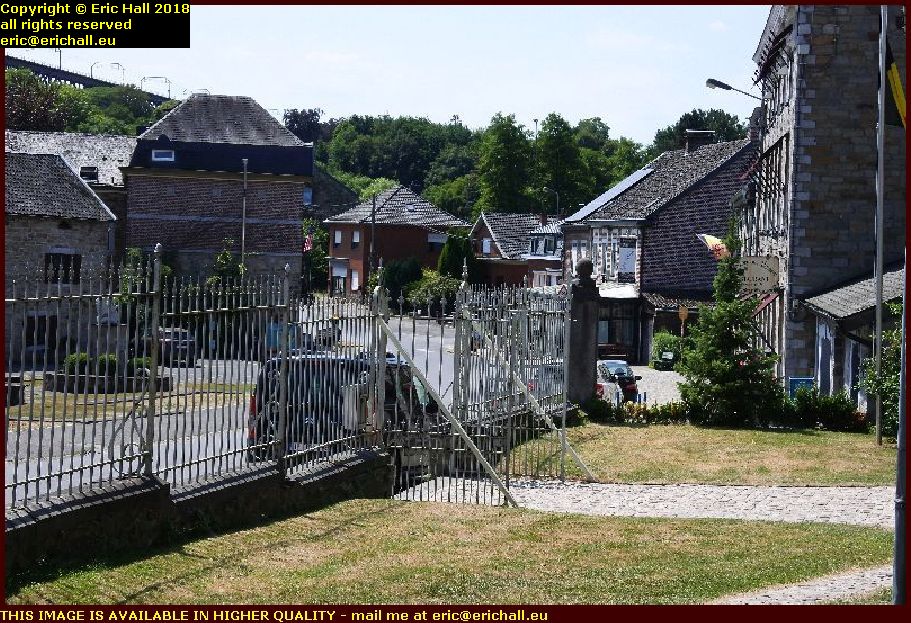 So while you admire the village of Moresnet and Alison and I have gone for a coffee with the friendly young girl who runs the village café, let me tell you a little story.
So while you admire the village of Moresnet and Alison and I have gone for a coffee with the friendly young girl who runs the village café, let me tell you a little story.
At the end of the Napoleonic Wars the Treaty of the Limits in 1816 redefined the border between the Low Countries (because Belgium didn’t exist at that time) and the Kingdom of Prussia.
For various reasons, they couldn’t agree with what to do with the commune of Moresnet and so they planned to divide it between them.
 Unfortunately, any logical dividing line ran right through a very important and valuable quarry and they couldn’t agree where the line should go so that each country would have half the value.
Unfortunately, any logical dividing line ran right through a very important and valuable quarry and they couldn’t agree where the line should go so that each country would have half the value.
Eventually, they agreed that the quarry and a surrounding piece of land would be a neutral zone administered jointly by one official from the Low Countries (Belgium after 1830) and the Kingdom of Prussia (the German Empire after 1871).
And so you had Moresnet, Neu-Moresenet (the German bit) and Moresnet Neutre.
In 1914 Germany took all of it, so at the Treaty of Versailles Belgium was awarded all of it, so in 1940 Germany took it all back and in 1945 Belgium regained all of it.
There has been quite a lot of excitement in such a sleepy little Belgian village
But our conversation with the serving wench was quite exciting. being practically right on one of Belgium’s linguistic borders, our conversation drifted between French and German with hardly a pause.
Belgium is a fascinating country.
And if that’s not enough to be going on with, just up the road some time round about 1750 a miracle involving Mary the Mother of Jesus is said to have taken place
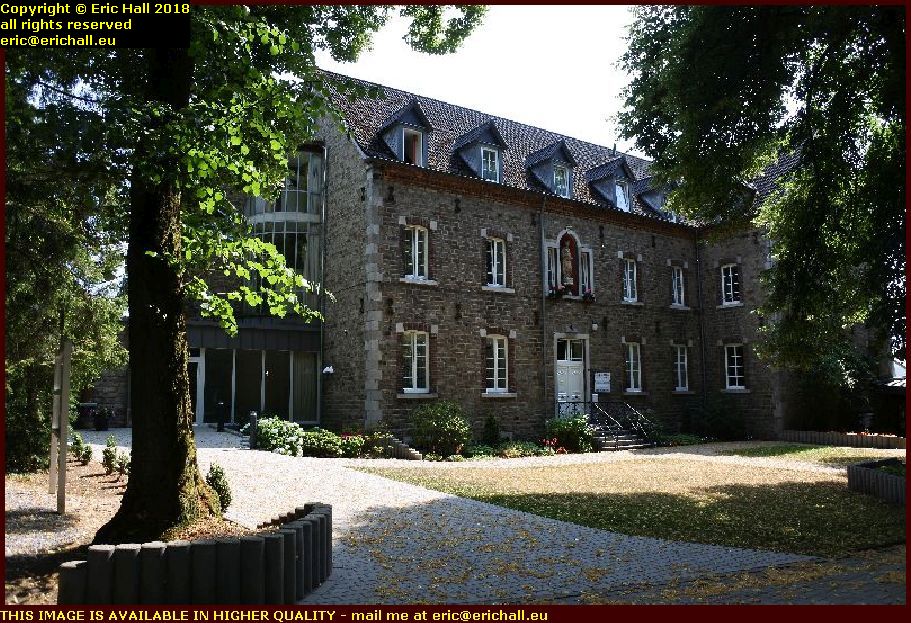 Pilgrims came to visit the site so a small chapel was built, followed by all of the usual facilities for the visitors, and the village of Moresnet-Chapelle developed.
Pilgrims came to visit the site so a small chapel was built, followed by all of the usual facilities for the visitors, and the village of Moresnet-Chapelle developed.
A group of Franciscan Friars (and seeing as this is Belgium, they were probably chip monks) were sent from Aachen in 1875 to provide spiritual comfort to the visitors.
As a result, some substantial development took place.
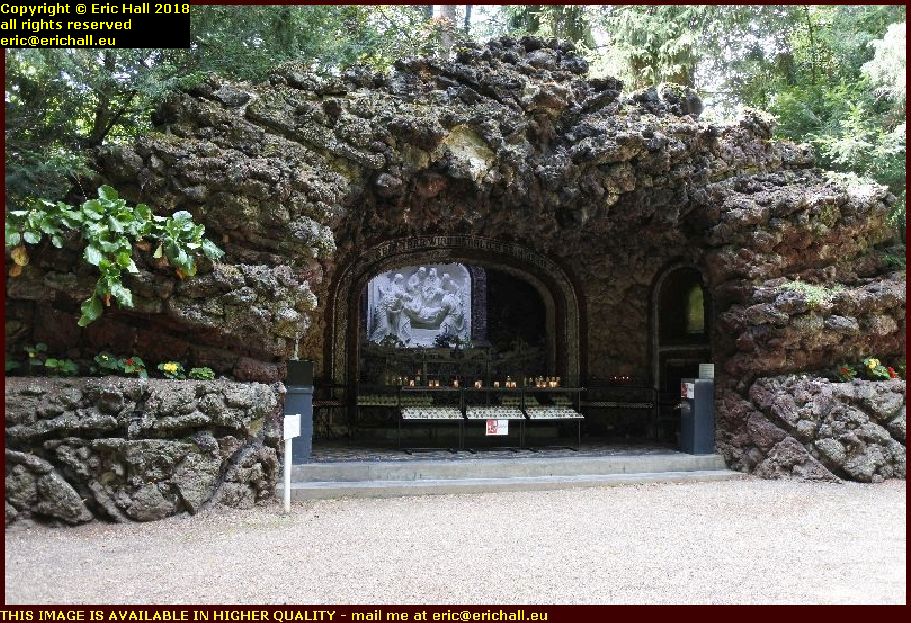 Regular readers of this rubbish will recall that we’ve talked on several occasions about the Chemin de la Croix – 14 stages of Jesus on his way to his crucifixion, death and subsequent resurrection.
Regular readers of this rubbish will recall that we’ve talked on several occasions about the Chemin de la Croix – 14 stages of Jesus on his way to his crucifixion, death and subsequent resurrection.
We’ve also been to see a a magnificent example of this at Cap de la Madeleine in Quebec.
In 1895 they decided that they would emulate it (the filthy beasts) right here.
 In 1895 German benefactor provided some cash to purchase the land around the chapel and they set to work.
In 1895 German benefactor provided some cash to purchase the land around the chapel and they set to work.
The work was completed in 1904 and today there are 14 grottoes made of puzzolane, each featuring one of the stages of the Chemin de la Croix.
The aim is to visit each one, purchase a candle to light in each (which must bring in a fortune) and say a prayer at each one, in order to be absolved of your sins.
Of course, I don’t need to, for regular readers of this rubbish in one of its previous guises will recall that I was granted absolution by the Pope, having passed through all of the Holy Doors in Rome during the Period of Grace in 2000.
I choose my friends carefully as you know.
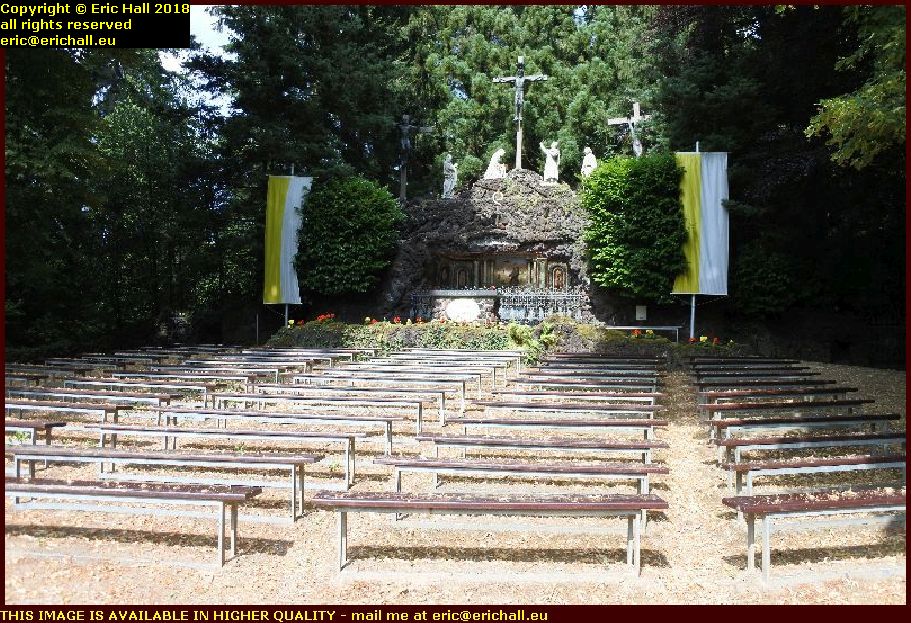 The twelfth station, the Calvaire or Calvary, featuring the crucifiction, is always a good ‘un and there’s no exception here.
The twelfth station, the Calvaire or Calvary, featuring the crucifiction, is always a good ‘un and there’s no exception here.
In fact, it was so popular at one time that they have installed benches here and occasionally hold open-air church services here.
But clearly not masses, because the place is pretty-much deserted today.
And I shan’t bore you all by repeating the story that a Frenchman delightfully told me, that they asked for a famous sculptor from each country to send in their impressions of how the Calvary should look, and the Belgian sculptor sent in a drawing of John Wayne on his horse.
Final stop (for now, anyway) on our day out was just a couple of miles up the road.
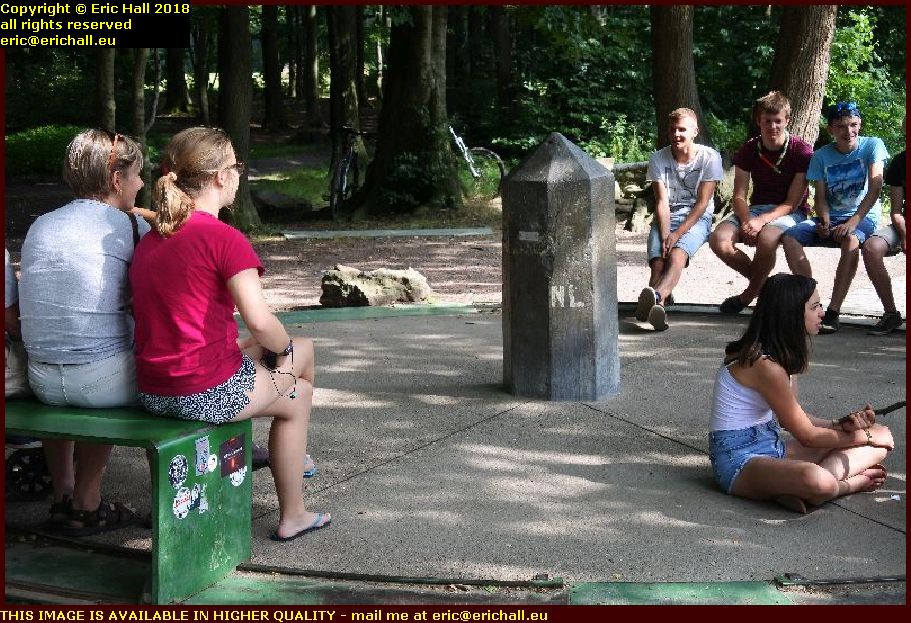 Here we have the Driehoek – or “Three Corners” – where the countries of the Netherlands, Belgium and Germany meet.
Here we have the Driehoek – or “Three Corners” – where the countries of the Netherlands, Belgium and Germany meet.
And when we had Moresnet-Neutre, it was a Vierhoek because that area had a bit of it too.
The girl in red is sitting half in the Netherlands and half in Germany, and the girl on the floor is half in the Netherlands and half in Belgium.
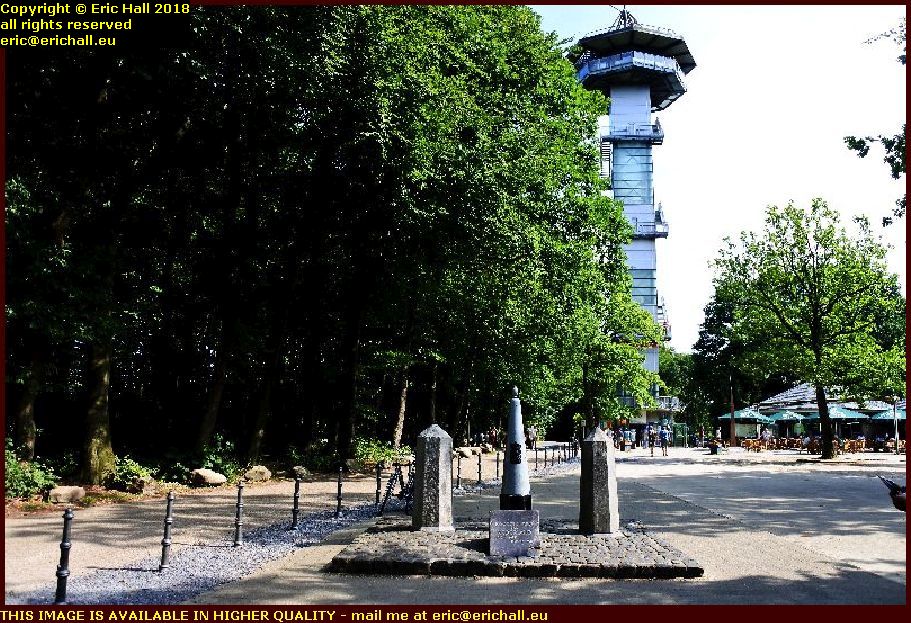 Not only that, the highest point in the Netherlands – the Vaalserberg – is only 100 metres or so from the border and so we had to pay that a visit too.
Not only that, the highest point in the Netherlands – the Vaalserberg – is only 100 metres or so from the border and so we had to pay that a visit too.
It’s all of 322.4 metres above sea level, or 1,058 feet for those of you still dealing in real money.
And in the background you can see an observation platform. Apart from the fact that it cost real money to go up there to the top, the number of steps that I saw was enough to put me off the idea.
So having been driven up the Vaal(serberg) our next stop was across in our third country of the day – Germany. And those silly Brits who voted to leave the EU just don’t understand the advantages of having Breakfast in Brussels, Lunch in Luxembourg, Tea in Turin, Supper in Sampdoria and Bed in Bari.
Aachen in fact was where we went, where Alison wanted to take me to a café that she had found. And even though we arrived 12 minutes before the advertised closing time of 18:00, they refused to serve us.
Consequently we nipped to Mullers for some of my white coconut chocolate, and then to the cat café that we had visited a while ago.
The cooking smelt delicious so Alison had some thick soup and I had hummus with raw vegetables and bread.
It’s not far back to Liège from Aachen, even though you pass through three countries to get there. and I was in time to see Russia defeated by Croatia. And I could tell by the way that the first Russian limped up to take his penalty, head bowed to the ground, that he was going to miss it.
Tomorrow I am on the move, and so an early night – if my neighbours let me. They are being just a little rowdy, but then you can’t win a coconut every time, can you?





